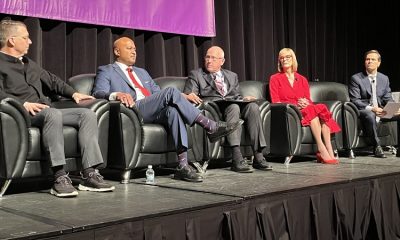U. S. News
NASA’s Mars helicopter takes flight, 1st for another planet

CAPE CANAVERAL, Fla. — NASA’s experimental helicopter Ingenuity rose into the thin air above the dusty red surface of Mars on Monday, achieving the first powered flight by an aircraft on another planet.
The triumph was hailed as a Wright brothers moment. The mini 4-pound (1.8-kilogram) copter even carried a bit of wing fabric from the Wright Flyer that made similar history at Kitty Hawk, North Carolina, in 1903.
It was a brief hop — just 39 seconds and 10 feet (3 meters) — but accomplished all the major milestones.
“Goosebumps. It looks just the way we had tested,” project manager MiMi Aung said as she watched the flight video during a later briefing. “Absolutely beautiful flight. I don’t think I can ever stop watching it over and over again.”
The $85 million helicopter demo was considered high risk, yet high reward.
Scientists cheered the news from around the world, even from space, and the White House offered its congratulations.
“A whole new way to explore the alien terrain in our solar system is now at our disposal,” Nottingham Trent University astronomer Daniel Brown said from England.
This first test flight — with more to come by Ingenuity, the next as soon as Thursday — holds great promise, Brown noted. Future helicopters could serve as scouts for rovers, and eventually astronauts, in difficult, dangerous places.
Ingenuity has provided a third dimension to planetary exploration and ”freed us from the surface now forever,” said JPL director, Michael Watkins.
Ground controllers had to wait more than three excruciating hours before learning whether the preprogrammed flight had succeeded 178 million miles (287 million kilometers) away. The first attempt had been delayed a week because of a software error.
When the news finally came, the operations center filled with applause, cheers and laughter. More followed when the first black and white photo from Ingenuity appeared, showing the helicopter’s shadow as it hovered above the surface of Mars.
“The shadow of greatness, #MarsHelicopter first flight on another world complete!” NASA astronaut Victor Glover tweeted from the International Space Station.
Next came stunning color video of the copter’s clean landing, taken by Perseverance, “the best host little Ingenuity could ever hope for,” Aung said in thanking everyone.
The helicopter hovered for 30 seconds at its intended altitude of 10 feet (3 meters), and spent 39 seconds airborne, more than three times longer than the first successful flight of the Wright Flyer, which lasted a mere 12 seconds on Dec. 17, 1903.
To accomplish all this, the helicopter’s twin, counter-rotating rotor blades needed to spin at 2,500 revolutions per minute — five times faster than on Earth. With an atmosphere just 1% the density of Earth’s, engineers had to build a helicopter light enough — with blades spinning fast enough — to generate this otherworldly lift. The Martian wind was relatively gentle Monday: between 4 mph and 14 mph (7 kph to 22 kph).
More than six years in the making, Ingenuity is just 19 inches (49 centimeters) tall, a spindly four-legged chopper. Its fuselage, containing all the batteries, heaters and sensors, is the size of a tissue box. The carbon-fiber, foam-filled rotors are the biggest pieces: Each pair stretches 4 feet (1.2 meters) tip to tip.
Ingenuity also had to be sturdy enough to withstand the Martian wind, and is topped with a solar panel for recharging the batteries, crucial for surviving the minus-130 degree Fahrenheit (minus-90 degree-Celsius) Martian nights.
NASA chose a flat, relatively rock-free patch for Ingenuity’s airfield. Following Monday’s success, NASA named the area for the Wright brothers.
“While these two iconic moments in aviation history may be separated by time and … million miles of space, they now will forever be linked,” NASA’s science missions chief Thomas Zurbuchen announced.
Up to five increasingly ambitious flights are planned, and they could lead the way to a fleet of Martian drones in decades to come, providing aerial views, transporting packages and serving as lookouts for human crews. On Earth, the technology could enable helicopters to reach new heights, doing things like more easily navigating the Himalayas.
Ingenuity’s team has until the beginning of May to complete the test flights so that the rover can get on with its main mission: collecting rock samples that could hold evidence of past Martian life, for return to Earth a decade from now.
The team plans to test the helicopter’s limits, possibly even wrecking the craft, leaving it to rest in place forever, having sent its data back home.
Until then, Perseverance will keep tabs on Ingenuity. Flight engineers affectionately call them Percy and Ginny.
“Big sister’s watching,” said Malin Space Science Systems’ Elsa Jensen, the rover’s lead camera operator.
-

 Local News2 weeks ago
Local News2 weeks agoCouncil of Bloomington overrides mayor’s veto of resolution calling for a ceasefire in Gaza
-

 Local News2 weeks ago
Local News2 weeks agoAttorney General Rokita offers her opinion on the use of pronouns at work
-

 Local News2 weeks ago
Local News2 weeks agoThe positions of the Republican gubernatorial candidates regarding taxes
-

 Local News1 week ago
Local News1 week ago$50,000 Truck stop sells Powerball tickets that are about to expire
-

 Indiana1 week ago
Indiana1 week agoAnderson man sentenced to 65 years for wife murder
-

 Indiana2 weeks ago
Indiana2 weeks agoWoman from Aurora detained for assaulting a child
-

 Local News2 weeks ago
Local News2 weeks agoBehold the spectacle that is Good Gravy!
-

 Local News1 week ago
Local News1 week ago$75 million “luxury urban” townhomes and condos with rooftop terraces are set to begin construction





Leave a Reply